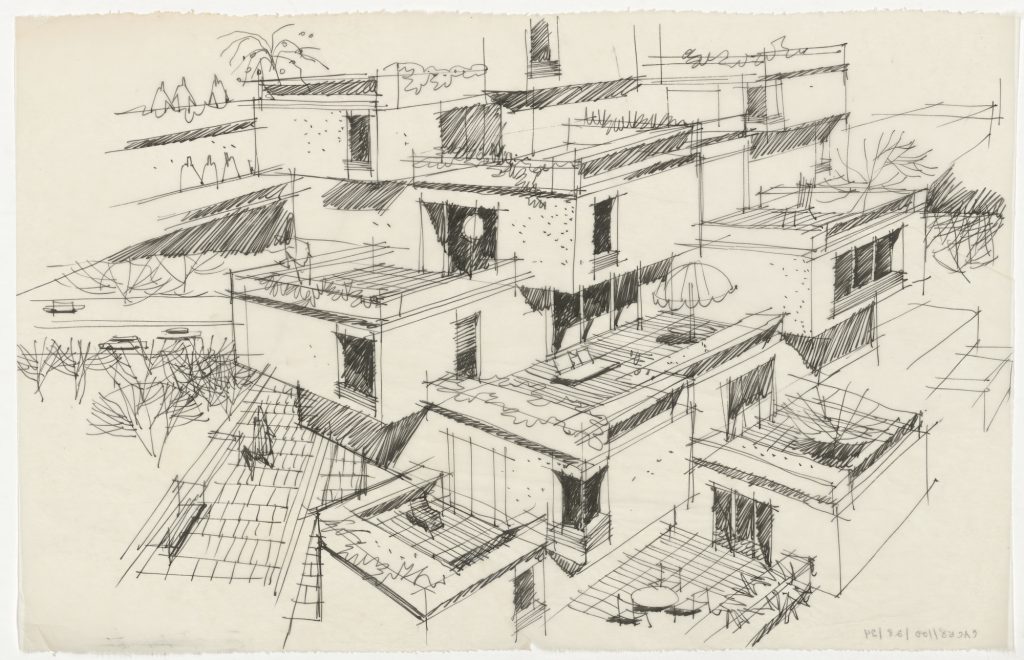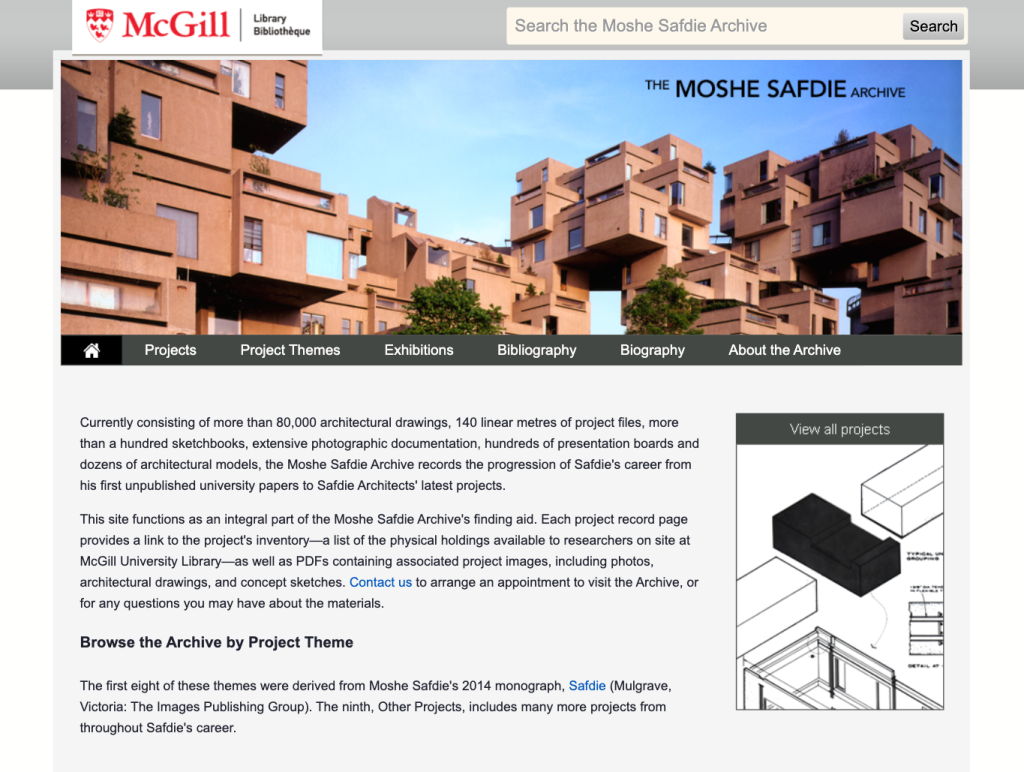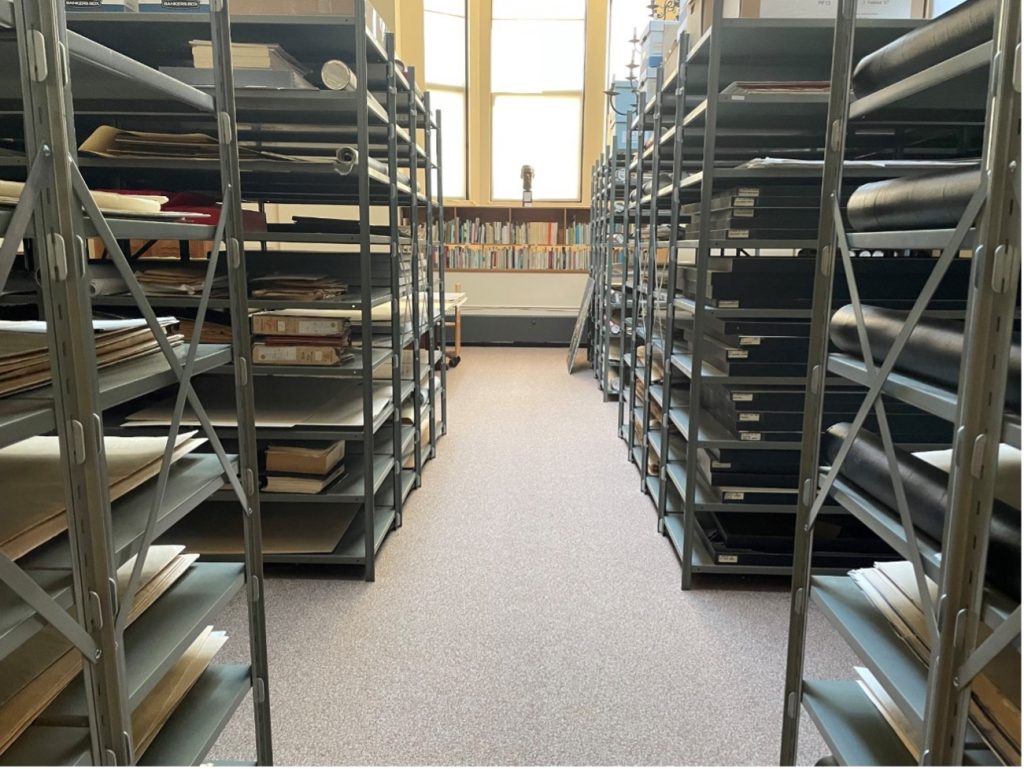By Tellina Liu, Archivist & liaison librarian for the Moshe Safdie Archive
The story of Moshe Safdie’s professional practice and student works can be found in his archive. Now this incredible body of work has made its way home to where it all started – McGill. Tellina Liu, Archivist & liaison librarian for the Moshe Safdie Archive, walks us through past, present, and future moments of engagement with the collection.

The gift of a world-renowned architect’s professional archive to any institution is noteworthy, and recently, Moshe Safdie’s permanent donation of his collection to McGill University Library has been widely celebrated. While the focus on the collection is of the moment, the collection dates to 1990. As an alumnus of McGill University’s School of Architecture, Moshe Safdie selected McGill University as the home for his professional archives. The Safdie Collection, housed in the McGill Library, and part of the John Bland Canadian Architecture Collection, has over 80,000 architectural drawings, 140 linear metres of project records, sketchbooks, photographs, models, and audio-visual material.
The collection begins in the 1960’s with Safdie’s student work and includes his McGill undergraduate thesis report, “A Case for City Living,” which he later adapted for the design of Habitat ’67. The Habitat ’67 series of materials is the largest in the collection and contains over 150 folders, with sketches, drawings, photographs, and project files. Other notable projects include the National Gallery of Canada in Ottawa, the Yad Vashem Holocaust Memorial in Jerusalem, the Marina Bay Sands Integrated Resort in Singapore, and the Khalsa Heritage Center in India. Currently, the archival collection at McGill reflects the first half of Safdie’s career, with the remainder to be received from his office in Somerville, Massachusetts, in the near future for processing and cataloging.
As the newly hired archivist curating this collection, it would be remiss of me to not acknowledge its history at McGill University and the extent of the work that has already been completed. Our architectural archive supports the needs of the School of Architecture and the School of Urban Planning, archivists properly preserved physical materials, maintained original order by arranging by project, and made the information available to students and other researchers. The collection holdings and project descriptions can be found on the Safdie Archive website, created in 2015 through a collaborative project between Safdie Architects and multiple McGill Library departments, including Digital Initiatives, Collection Services, Office of Copyright Compliance, and ROAAr. A previous version of the website from 1998 still exists and remains a resource for researchers.

Additionally, collection archivists and curators have collaborated with external groups to create exhibitions that makes use of Safdie Archive materials. From 2010 through 2016, the Crystal Bridges Museum of American Art and the Skirball Cultural Center curated a major exhibition titled, “Global Citizen: The Architecture of Moshe Safdie,” utilizing archival materials from the collection. This traveling exhibition “explore[d] Safdie’s structures and the philosophy that shapes them”, included 175 drawings, sketches, photographs, and models and traveled through the United States and Canada1. From October 2022 through January 2023, an exhibition titled “With Intention to Build: The Unrealized Concepts, Ideas, and Dreams of Moshe Safdie,” was held at Boston Architectural College and “[took] viewers through the evolution of concepts and ideas developed over a 55-year practice.” The exhibition focused on some of Safdie’s most important unbuilt project and featured archival models from the collection.
My position was specially created to steward the Safdie Archive, and my primary focus will be to continue the work started by my predecessors and to ensure accessibility for researchers. This work will include accessioning more recent projects and working with McGill University colleagues to make project information easily discoverable online. I also intend to explore the collection to find lesser-known projects, highlighting them, as well as new themes and access points to support research and learning for McGill architecure and urban planning students. I am already working closely with the team at Safdie Architects; a potential project is to find a way to share his sketchbooks which have already been digitized. We are also exploring collaborations with other institutions linked to Safdie projects. These collaborations will result in expanded outreach and access, the creation of exhibitions and lecture series, and allow me to explore new avenues to connect to a variety of audiences interested in architecture, history, and other subjects found within the Safdie Archive.

1. McGill University Library (n.d.). Exhibitions. The Moshe Safdie Archive. Retrieved March 28, 2023, from https://cac.mcgill.ca/moshesafdie/exhibitions.html
2. Boston Architectural College (n.d.). With Intention to Build: The Unrealized Concepts, Ideas, and Dreams of Moshe Safdie. McCormick Galley Events. Retrieved March 28, 2023, from https://the-bac.edu/events-index/with-intention-to-build-mccormick-gallery-exhibit
Une plongée dans les archives de Moshe Safdie
Par Tellina Liu, archiviste et bibliothécaire de liaison des archives Moshe Safdie
L’histoire de la pratique professionnelle et des travaux d’étude de Moshe Safdie sont accessibles dans ses archives. Désormais, cet ensemble incroyable a trouvé le chemin de McGill, là où tout a commencé. Tellina Liu, archiviste et bibliothécaire de liaison des archives Moshe Safdie, nous guide dans le passé, le présent et le futur de la consultation de la collection.

Le don des archives professionnelles d’un architecte de renommée mondiale est certes digne de mention et, dernièrement, le don permanent qu’a fait Moshe Safdie de sa collection à la Bibliothèque de McGill a été largement salué. Si le thème de la collection est d’actualité, celle-ci a été constituée en 1990. En qualité de diplômé de l’École d’architecture de McGill, Moshe Safdie a retenu son alma mater comme foyer de ses archives professionnelles. La Collection Safdie, qu’abrite la Bibliothèque de McGill, et qui s’intègre à la Collection d’architecture canadienne John Bland, est riche de plus de 80 000 dessins d’architecture, de 140 mètres linéaires de dossiers de projets, de carnets de croquis, de photographies, de maquettes et de matériel audiovisuel.
La Collection commence dans les années 1960 avec les travaux d’étudiant de Safdie et comprend son rapport réalisé en premier cycle d’études à McGill, A Case for City Living, qu’il adapte plus tard pour le design d’Habitat 67. La série Habitat 67, la plus importante de la collection, contient plus de 150 dossiers d’ébauches, de croquis, de photographies et de dossiers. Au nombre des autres projets notables, mentionnons le Musée des beaux-arts du Canada, à Ottawa, l’Institut international pour la mémoire de la Shoah Yad Vashem, à Jérusalem, le Marina Bay Sands Integrated Resort, à Singapour, et le Khalsa Heritage Center en Inde. À l’heure actuelle, les archives de McGill portent sur la première moitié de la carrière de l’architecte; le reste nous proviendra sous peu de son cabinet sis à Somerville, au Massachusetts, aux fins de préparation et de catalogage.
À titre d’archiviste embauchée dernièrement pour administrer cette collection, je serais négligente de passer sous silence son histoire à l’Université McGill et la portée du travail déjà accompli. Nos archives d’architecture répondent aux besoins de l’École d’architecture et de l’École d’urbanisme grâce aux objets que les archivistes ont préservés adéquatement, dont ils ont maintenu l’ordre original en les classant par projet et rendu l’information aux étudiants et aux autres chercheurs. La Collection et les descriptions de projet se trouvent dans le site Web des Archives Safdie créé en 2015 et fruit d’un projet de collaboration entre le cabinet Safdie Architects et de multiples départements de la Bibliothèque de McGill, dont les Initiatives numériques, les Services aux collections, le Bureau de conformité au droit d’auteur et le groupe ROAAr. Il existe toujours une version du site Web qui remonte à 1998 et qui demeure une ressource à la disposition des chercheurs.

https://cac.mcgill.ca/moshesafdie/index.php
De plus, des archivistes des collections et des conservateurs ont collaboré avec des groupes à l’externe pour créer des expositions qui puisent à même les Archives Safdie. De 2010 à 2016, le Crystal Bridges Museum of American Art et le Skirball Cultural Center ont organisé une grande exposition intitulée Global Citizen: The Architecture of Moshe Safdie (Citoyen du monde : l’architecture de Moshe Safdie) à l’aide du matériel de la collection. Cette exposition ambulante, « qui explore[ait] les structures de Safdie et la philosophie qui les façonne(ait) », comprenait 175 dessins, esquisses, photographies et maquettes, et elle a circulé aux États-Unis et au Canada1. D’octobre 2022 à janvier 2023, l’exposition “With Intention to Build: The Unrealized Concepts, Ideas, and Dreams of Moshe Safdie (L’Intention de construire : Concepts, idées et rêves non concrétisés de Moshe Safdie)” a été présentée au Boston Architectural College et « [a mené] le public à travers l’évolution de concepts et d’idées formulés au cours d’une période d’activité de 55 ans ». L’exposition portait principalement sur certains des projets de Safdie non réalisés et comprenait des modèles d’archives extraits de la Collection2.
Mon poste a été créé spécialement pour veiller sur les Archives Safdie, et je m’attacherai d’abord à poursuivre le travail qu’ont entrepris mes prédécesseurs et à assurer la disponibilité pour les chercheurs. Pour ce faire, je devrai consigner les projets les plus récents et travailler avec des collègues de McGill pour rendre l’information facilement accessible en ligne. Je veux de plus explorer le fonds pour y déceler et mettre en évidence des projets moins connus, de même que pour formuler de nouveaux thèmes et points d’accès à l’appui de la recherche et de l’apprentissage à l’intention des étudiants en architecture et en urbanisme de McGill. Je collabore déjà étroitement avec l’équipe du cabinet Safdie Architects à un projet éventuel de partage des carnets de croquis déjà numérisés. Nous explorons également la collaboration avec d’autres établissements associés aux projets de Safdie pour améliorer la portée et l’accès, la création d’expositions et d’une série de conférences et pour me permettre d’explorer de nouvelles voies de communication avec divers auditoires qui s’intéressent à l’architecture, à l’Histoire et à d’autres sujets abordés dans les Archives Safdie.

1. McGill University Library (n.d.). Exhibitions. The Moshe Safdie Archive. Retrieved March 28, 2023, from https://cac.mcgill.ca/moshesafdie/exhibitions.html
2. Boston Architectural College (n.d.). With Intention to Build: The Unrealized Concepts, Ideas, and Dreams of Moshe Safdie. McCormick Galley Events. Retrieved March 28, 2023, from https://the-bac.edu/events-index/with-intention-to-build-mccormick-gallery-exhibit













Leave a Reply
You must be logged in to post a comment.